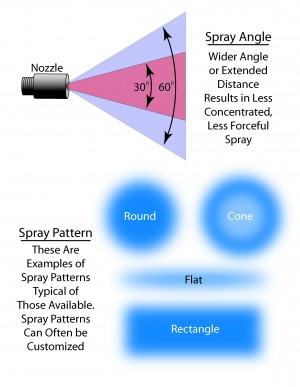Previous blogs have suggested the use of liquid sprays in air as either a primary mechanism or as an enhancement to both cleaning and rinsing operations. Today’s blog will discuss, briefly, what is important in choosing a spray nozzle or nozzles for a particular application. In order for spray to be effective, of course, the surface to be cleaned or rinsed must be “visible” to the nozzle. Although there is some benefit to a flow of water from a spray flowing over concealed or “hidden” surfaces, the primary effect of a spray is achieved where the airborne spray impinges on or “hits” the surface being processed. The range of spray nozzle configurations available for use in spraying liquids in air is almost unlimited. Each variation has a purpose. Selecting the proper nozzle for a particular application boils down to a few, quite simple parameters.
The simplest spray “nozzle” is a hole or series of holes drilled into a length of pipe. It is almost intuitive that a larger hole will allow more liquid to exit but at a lower velocity. Increasing the number of holes will result in less liquid flowing from each hole and, generally, with lower force if the liquid supply remains constant. Although this arrangement has application in some instances, it is more common to use nozzles to replace the simple holes in the pipe. Spray nozzles do several things –
- Regulate the velocity and magnitude of liquid flow
- Define the shape of the spray pattern
- Allow precise aiming of spray to assure that its effect is delivered efficiently
Velocity and Flow –

As stated above, it is almost intuitive that a larger “orifice” or “hole” will allow more liquid to flow. If the pressure of the source remains constant, increasing the orifice size will also result in the liquid exiting the orifice moving at a reduced velocity. Spray nozzles are usually rated with a pressure and flow rate. A typical rating might be .5 gallons per minute at a pressure of 65 pounds per square inch. What this means is that the pressure source which may be a pump or line pressure from the water main must be able to provide .5 gallons of liquid per minute at the specified pressure for the nozzle to operate to its specification. Reduced pressure will result in decreased flow and spray velocity and, in most cases, increased pressure will result in increased flow and velocity.
Spray Pattern –
The “hole in a pipe” concept provides a pretty much uncontrolled stream of liquid issuing from the orifice. Spray nozzles have orifices and geometries which are designed to shape the pattern of the spray they create. Typically, a nozzle specification describes a cross-sectional pattern of the spray that nozzle produces and an angle of dispersion, examples of which are shown at the illustration above.
It is important to note that the pattern and spray dispersion are those produced by the nozzle at specified flow rate and pressure. Depending on the nozzle, a change in pressure or flow rate may have a significant impact on either or both of these parameters and not necessarily in a predictable way. This all depends on the geometry of the nozzle and how it manages to shape the pattern of spray.
Aim –
The aim of a “hole in a pipe” spray is quite unpredictable. The angle of drilling, the presence of a burr or partial obstruction on the inside or outside of the hole and the direction of flow of liquid in the pipe can all produce varying results. Spray nozzles are usually quite true in their aim and, in some cases, can be individually adjusted to assure the spray is delivered precisely where it is needed.
Because the range of nozzle configurations is huge and due to the fact that selection of the proper nozzle is so important to the success of the application, cleaning equipment manufacturers pay particular attention in the selection nozzles. Likewise, users should be meticulous in replacing damaged, worn or clogged nozzles with replacements that exactly match those initially specified. A change in nozzle type or specification should only be considered if the desired result is a change in the operation of the machine.
This introduction, though brief, sets the stage for upcoming discussions of how to select and specify nozzles used in cleaning and rinsing operations which will be topics for upcoming blogs.
– FJF –



 English
English Spanish
Spanish Chinese
Chinese Canada
Canada Mexico
Mexico United Kingdom
United Kingdom



